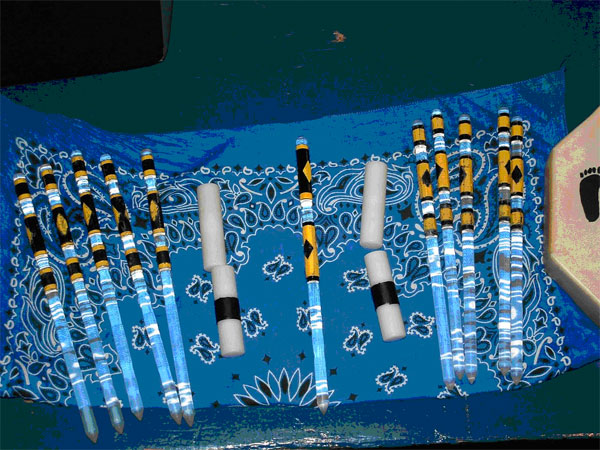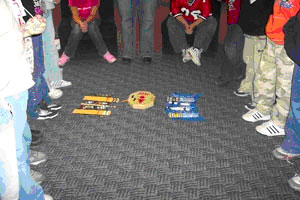| Mathematics | Close this window |

Background
"At the Indian Village at the Calgary Stampede, people play stick games. A long time ago, only men played stick games but now everybody does. Stick games are played with a pair of small bones and sticks. You start off with one team passing around the sticks and songs are sung and the drums are beat to distract and draw power to the hiding team. The other team tries to guess which hands hold the bones and if you guess right, you win sticks for your team."
Faith and Chelsey, Grade 4, Piitoayis Family School
This game is steeped in tradition, and many songs are associated with the game. Drummers and singers gather around the players to try and distract them and, as Faith and Chelsey say, "draw power" to the person who is hiding the bone. Sometimes the actual physical sticks are passed from generation to generation. This game, along with other hand games, can go all night and is still popular at powwows.
How to Play
Two players sit on the floor facing each other and the first player switches the bone (small stick) back and forth between his or her hands several times. The player makes two fists and hides the bone in one fist. He or she shows both fists to the guesser. The guesser tries to guess which hand holds the bone. If the guesser is correct, he or she takes a counting stick. If the guesser is incorrect, the first player takes a counting stick. Players take turns hiding the bone. The game is over when one player holds all the sticks.

Curriculum Connections (Probability)
This is a simple but elegant demonstration of the binomial distribution where n = number of sticks and p = 0.5, abbreviated B(n, p) or B(# of counting sticks, 0.5).
The probability of each player winning is equal if the number of counting sticks is an even number. The probability of the first player winning is higher if the number of counting sticks is odd.
Number sense
Grade 1: The number of times the game is played is the same as the number of counting sticks.
Grade 2: Demonstrate if a number is even or odd.
Grade 5: Apply mental mathematics strategies and number properties, such as skip counting from a known fact, using doubling or halving.
Grade 6: Demonstrate an understanding of factors and multiples by determining multiples and factors of numbers less than 100 (factor of 2).
Statistics and probability
Grade 5: Describe the likelihood of a single outcome occurring, using words. Compare the likelihood of two possible outcomes, using words.
Grade 6: Demonstrate an understanding of probability by:
- identifying all possible outcomes of a probability experiment
- differentiating between experimental and theoretical probability
- determining the theoretical probability of outcomes in a probability experiment
- determining the experimental probability of outcomes in a probability experiment
- comparing experimental results with the theoretical probability for an experiment.
Grade 7: Conduct a probability experiment to compare the theoretical probability (determined by using a tree diagram, table or other graphic organizer) and experimental probability of two independent events.
Grade 8: Solve problems involving the probability of independent events.
Grade 9: Demonstrate an understanding of the role of probability in society.

